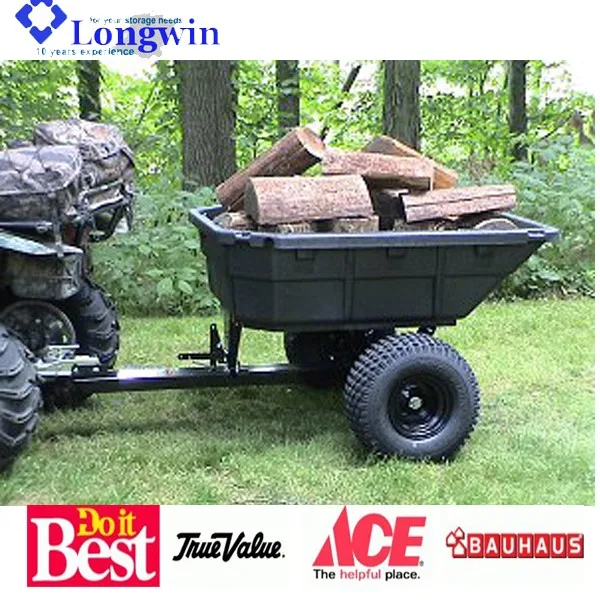All-terrain vehicles improve access to the backcountry. ATVs and side-by-sides excel at carrying people, but their restricted cargo room limits the gear we can haul in, and the meat we can pack out. To better suit my outdoor adventures and projects around my homestead, I needed more space to haul the necessary gear. It was time to build a utility trailer!
Advertisement
In the spirit of any good DIY project, salvaged materials kept my costs down. I used as much repurposed metal as possible to create my ATV trailer. When using old metal, good prep improves weld quality, so I brushed or ground off rust and old paint.
Advertisement
I rate this project as intermediate both for its required skill level and time to complete. To tackle this project, you’ll need access to a welder and a compliment of workshop tools. I chose wood planks for the decking, so a method to cut wood to length helps too. I’m not a welder by training, so there was a steep learning curve.
Nevertheless, using a MIG welder and attention to detail, I achieved ‘professional’ results.
The hardest part of the project was coming up with a design. Plan considerations included trailer purpose, bed size, ground clearance, tires, hitch, load capacity and overall trailer weight. Some of decisions were easy, based on locally available materials – type of hitch, for example. Others crystalized after much deliberation. With my trailer specs and materials in hand, it was time to start cutting.
Advertisement
I cut the metal parts with a chop saw, a bandsaw and a special thin cutting blade on an angle grinder – any of the three will work well. The three-foot by five-foot frame was built using one-and-a-half-inch square tubing, which is strong and makes a superb platform on which to mount everything else. Simple butt joints to make neat square corners simplified welding for a beginner. Using two-inch square tubing for extra strength, I welded the tongue at 26 inches, allowing ample clearance between the ATV and trailer, even during tight turns.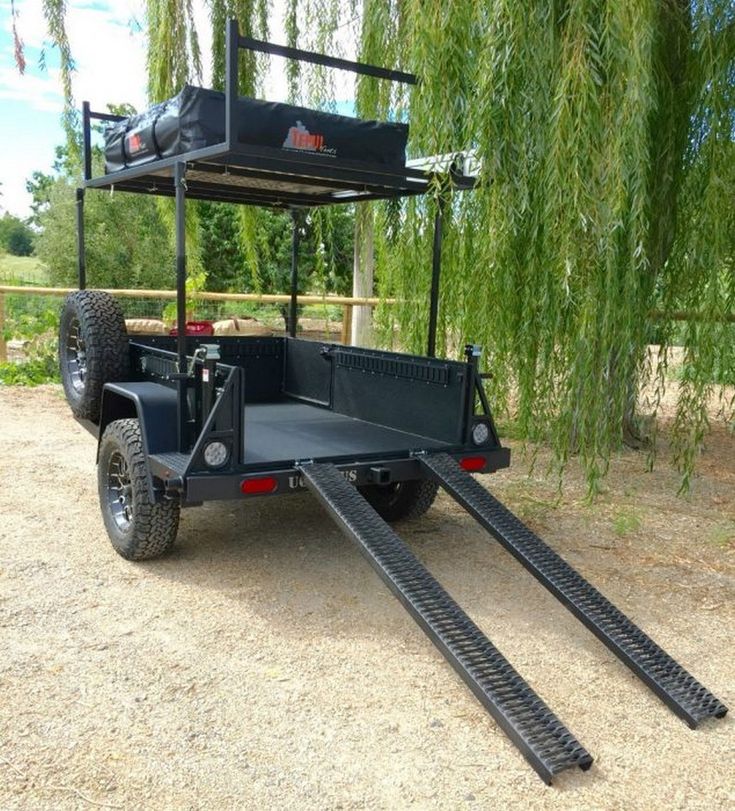 For frame strength and a place to secure the decking, I welded angle iron side to side across the trailer in strategic locations.
For frame strength and a place to secure the decking, I welded angle iron side to side across the trailer in strategic locations.
The wheel assembly is the most complicated part of this project. An online search returns several suitable ideas, from a simple straight axle with no suspension, to more complex walking axle designs. For me, design considerations included the type of tire. I opted for a standard 14-inch trailer tire and reduced the fabrication process by purchasing a pair of bolt-on equalizer torsion axles for a five-bolt rim. Swapping tire hubs to a four-bolt ATV style will accommodate off-road ATV-style floatation tires. I fabricated the axle supports using angle iron. Using the wheel assembly as a template, I marked and drilled holes to accommodate the bolts.
I used a wire wheel on an angle grinder to clean and rough up the metal surface of the trailer prior to painting. For paint, a rattle-can of spray paint for metal did the trick. To prevent slipping when wet, I plan to add a rubberized rocker guard paint on the tongue.
With the trailer still upside down, I bolted the axle assemblies to the frame and installed the tires. My wife and I easily lifted the trailer off the sawhorses and rotated it to sit on the ground right-side up. It wasn’t too heavy, yet!
Next was cutting the trailer decking – I used spruce 2x6s and 2x8s – securing them to the trailer using self-tapping metal screws into the angle iron supports. For longer life, I’ll paint the deck with a water seal. Treated lumber works well too, I just didn’t have any on hand at the time.
After the trailer frame and deck was built, it was time to focus on the sides. For now, I just needed a cart to haul logs and game out of the field, so I added arms that flare out from the trailer for more capacity. An alternative is quick-detach brackets and modular sides to slide in, to suit your adventure.
The last step was installing a trailer coupler. I used a standard part-store aluminum ball-hitch coupler, simply bolting the basic coupler through the tongue.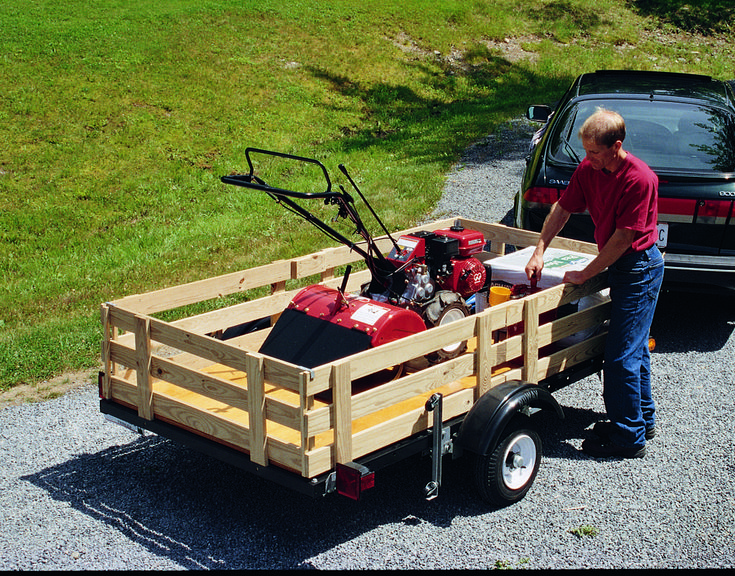 I admit, I do admire the swivel hitch designs for safety considerations in rough terrain – if you misjudge your centre of gravity, your cart can tip without flipping the ATV on its side as well.
I admit, I do admire the swivel hitch designs for safety considerations in rough terrain – if you misjudge your centre of gravity, your cart can tip without flipping the ATV on its side as well.
I had a great deal of fun researching and building this project. I learned new skills and created something that makes me proud to look at and use. Plus, I now have a custom trailer that is more solid and heavy-duty than most commercially made items of this size. If I wished to get it inspected and licenced, I could use it on the road behind my truck as well.
Have fun choosing your options and building your own utility trailer!
Step 1, plans and parts: I decided on the size, shape and parts specification for the trailer I wanted to build. I scrounged used metal where I could and purchased the parts and materials I needed.
Step 2, layout: Metal parts measured and marked in preparation for cutting.
Step 3, cutting: I used a chop saw to cut most of the metal parts to length.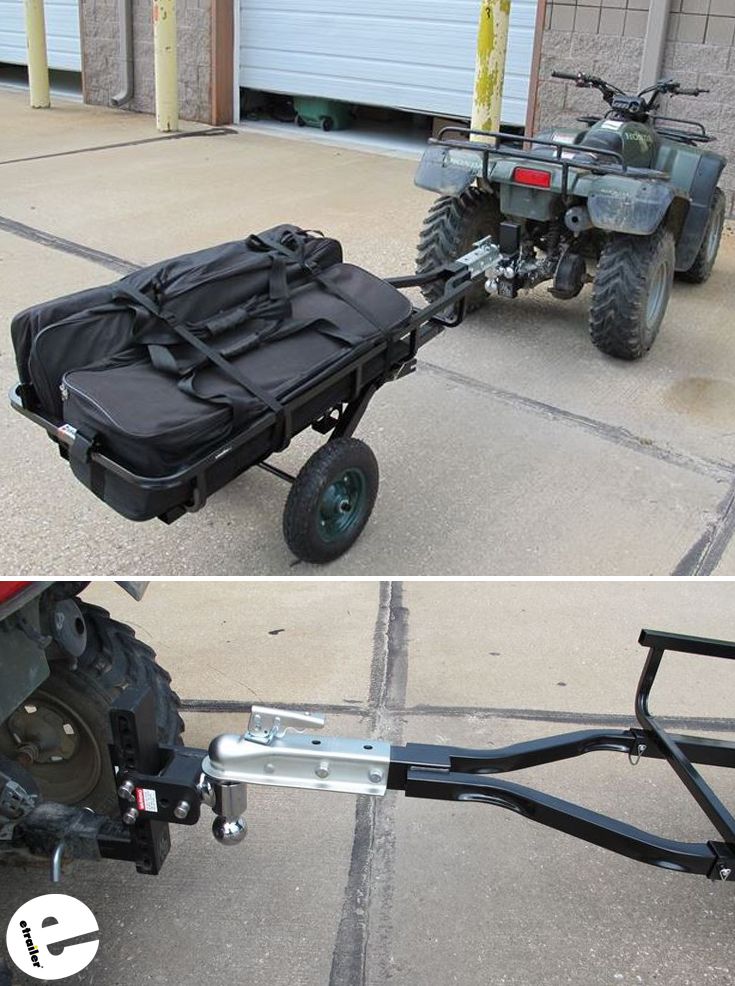 A metal cutting bandsaw is another method for cutting metal parts.
A metal cutting bandsaw is another method for cutting metal parts.
Step 4, metal preparation: Good metal preparation is crucial to good welds, especially when using recycled metal. Here, a wire brush on an angle grinder removes old paint and rust.
Step 5, welding: Magnetic clamps hold the workpiece while welding, keeping everything square. For the perfect fit, the axle assemblies were used as a spacer while the supports were tack-welded into place.
Step 6, painting: After welding the frame, the steel was painted before assembling.
Step 7A, assembly: The axel assemblies were bolted onto the frame supports, followed by tire installation.
Step 7B, assembly: The hitch coupler was bolted to the tongue to facilitate future upgrades or replacement.
Step 8, final details: Install side arms and pre-cut decking.
The final product, showing clearance, axel assembly and tires.
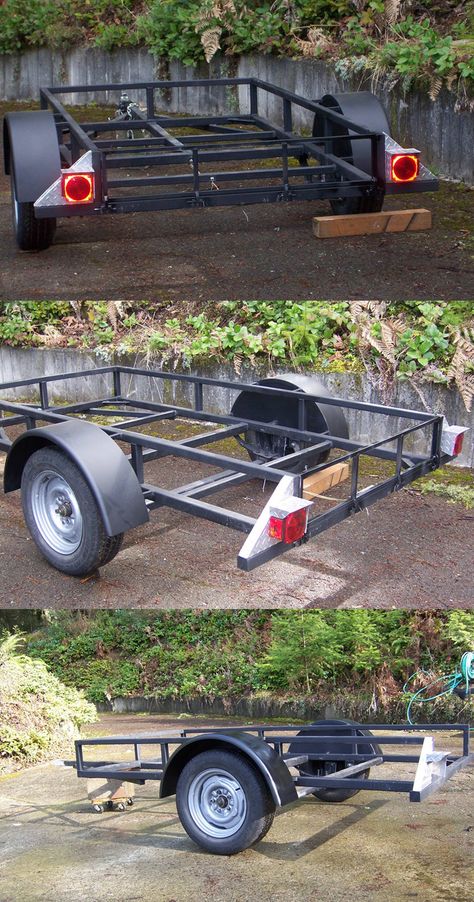
Our smallest ATV and off road vehicle specific trailer plans. Great for taking 2 ATV’s out, yet small enough for towing without a big truck. The size also makes for easier storage between the fun trips.
$ 19.99 - Complete Plans
* Plans are in a computer document. You may Save them to your computer immediately after Payment.
ATV trailer plans specifically designed for 2 ATV’s with the ramps needed to easily load and unload. Plans include several variations for customization like ramps that attach to the side for loading, and store under the trailer for traveling. This trailer has been engineered for strength, for functionality, and on-the-road stability! Check out all the features.
We offer two sizes of ATV trailers — Both versions accommodate 2 full size ATV’s.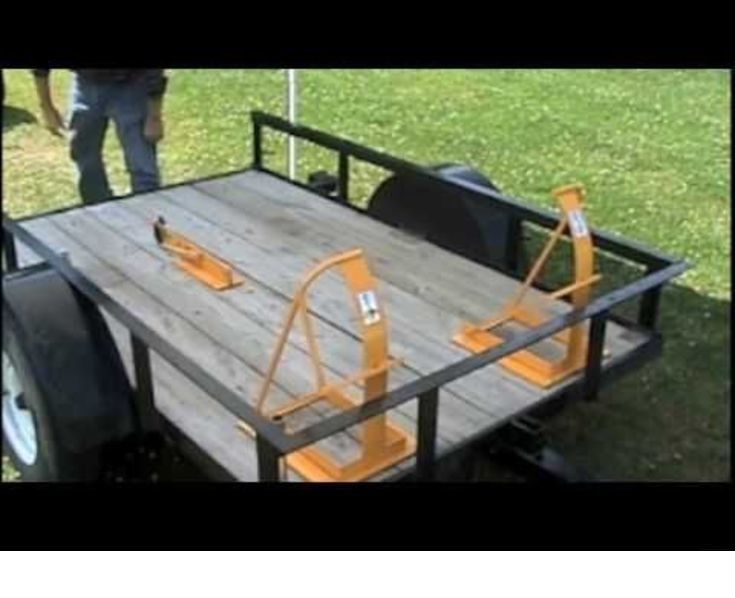 This is the smaller size (5’x 10.5′ bed), so it’s a little narrower and shorter but holds 2 ATV’s just the same. The narrower profile can be a benefit when towing with something other than a full size vehicle. The larger size (6’x 11′ bed) has a wider deck for a little extra bed space to carrying your extra gear. Both are designed for a single 3500# axle, and both come with lots of options for customizing the trailer to your needs.
This is the smaller size (5’x 10.5′ bed), so it’s a little narrower and shorter but holds 2 ATV’s just the same. The narrower profile can be a benefit when towing with something other than a full size vehicle. The larger size (6’x 11′ bed) has a wider deck for a little extra bed space to carrying your extra gear. Both are designed for a single 3500# axle, and both come with lots of options for customizing the trailer to your needs.
Note: Actual bed is slightly bigger than the stated size in feet.
Add To Cart
5′ x 10.5′ – 2 Place ATV Trailer Plans
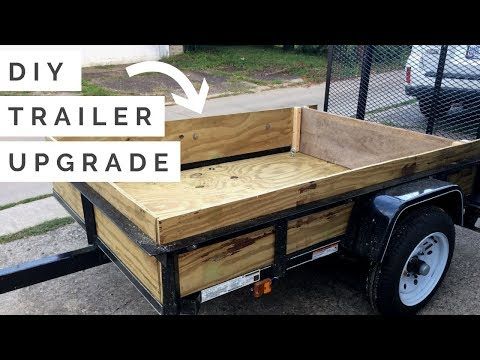
Add To Cart
Plans from Mechanical Elements are an awesome start to a great project. Here are even more resources!
First: For more info, please read: What's In The Plans? and What Makes Our Trailer Plans Better?
Second: Purchase plans with the "Add to Cart" button, then right after payment, a digital copy is ready to save to your computer. Please see this article for answers about getting the plans.
Third: We have many articles to help with trailer building. Just type a question in the Show Me bar (top of this page), then press "GO". Or, for simple browsing, visit Articles from the Mechanic.
Reminder:
Trailer building requires metal working skill and tools for things like cutting, drilling, and accurate set-up, as well as welding skill. Strength, durability, and enjoyment depend on building the trailer well.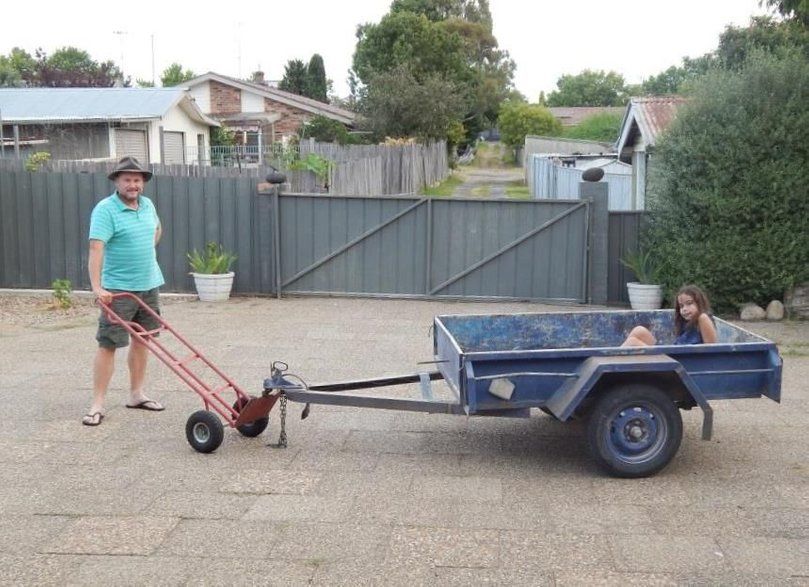 Build it well, then Enjoy the Finished Project !!
Build it well, then Enjoy the Finished Project !!
* Trailer load capacity depends on all the parts and materials, as well as the craftsmanship in building. All Mechanical Elements trailers are engineered to perform as stated when built as defined with proper care in construction – including parts, material, construction techniques, weld integrity, assembly methods, and finishing. Capacity for this trailer also requires proper choices for parts such as the hitch, axle(s), wheels, tires, safety chain, decking, bolts, pins, etc. Please make sure component load capacities match or exceed the trailer total capacity. Do not exceed manufacturers limits.
For trouble-free trailer life, think care and safety. Please select fastening methods to handle how and where the trailer will operate – including vibration, proper fastener types, bolt grades, torques, and nut types (like lock nuts). Then, be smart about loading the trailer, load distribution, tire pressure, tire condition and the mechanics of towing. We want you safe to enjoy your trailer for a long time ahead. Always use proper safety and securing equipment when loading and towing a trailer.
We want you safe to enjoy your trailer for a long time ahead. Always use proper safety and securing equipment when loading and towing a trailer.
Thank You — The Mechanical Elements Team
Article
There is some disagreement in trailer building about how to weld-on trailer spring brackets (also known as spring hangers). Some of you have sent questions about which techniques are best, especially
Read The Article
Product
A small-ish, yet really tough little trailer. Get these single axle 4x8 Utility Trailer Plans to get the jobs done. With a total capacity of 3500 lbs., trailers built from these plans will work hard.
See The DetailsAdd To Cart
Product
Blueprints for a Strong and Stable 6x12 utility trailer. This single axle, 3500# capacity trailer with many options is ideal for a million uses. We provide great DIY Plans for builders who want the best.
This single axle, 3500# capacity trailer with many options is ideal for a million uses. We provide great DIY Plans for builders who want the best.
See The DetailsAdd To Cart
Article
Sometimes looking for the right plans for the trailer you need is a needle in a haystack. Every site has something, but not exact. What’s next? When you really need a particular trailer that others don’t offer,
Read The Article
Article
Some Trailer Plans don’t use a standard axle size. Why not? Good question, along with the also common “Why should I special order the trailer axle? There are a few common-ish axle sizes
Read The Article
Article
It’s time to welcome the tilt top trailer. You, as customers and readers, request this a lot, for a while. So, now we have it. Rather than revisiting the design for all our trailers in all the sizes, we now…
Read The Article
Article
Need Plans to build a better built Dump Trailer? How about a 7′ x 14′ dump bed with 14,000 lbs trailer capacity.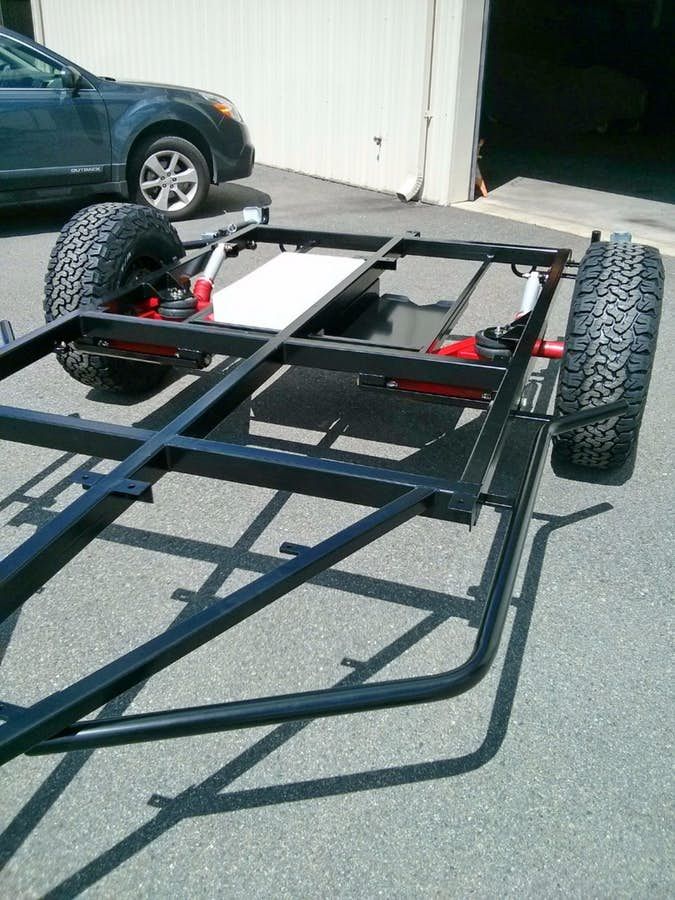 I can tell you where to get them, and we know the plans are great, because Synthesis Engineering…
I can tell you where to get them, and we know the plans are great, because Synthesis Engineering…
Read The Article
Article
What if . . . You want to live Tiny, but not “that” tiny? Sure, there are a lot of attractive elements with living Tiny, but to some, the 8 foot width is just too tight. If that’s you, go…
Read The Article
Article
Virtually everything on the internet is by definition “World Wide”. Even though Mechanical Elements (Synthesis Engineering Services) is physically located in the USA, we have a world audience, so it’s a fair question
Read The Article
Article
Where do you get plans for true, tough, Car Hauler trailers. After a ton of market and product study, we are stepping in and stepping up. Our niche is engineering better plans for DIY, so read on to learn about…
Read The Article
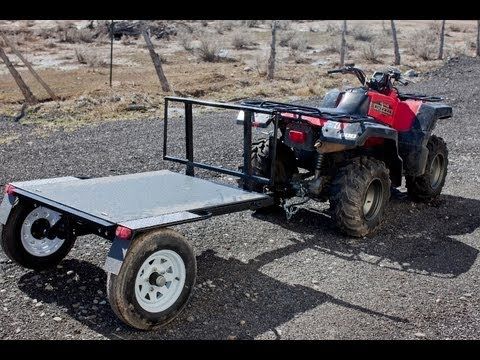 Homemade ATV trailer
Homemade ATV trailer ATV is a powerful four-wheeled vehicle with high cross-country ability. Owners love it very much for unpretentiousness and durability. Such transport can be used to transport quite serious goods, but this requires a special trailer for an ATV. Help in the economy from such an acquisition will be great, because the power of the ATV is enough to transport loads weighing a thousand kilograms. There is only one question left - the trailer.
A trailer is a box on wheels that can carry small loads. It is usually attached at the back. An ATV trailer differs from a car or other kind of transport only in size. This is a very important factor. If the trailer is wider than the quad itself, then it will be difficult to maneuver, and in narrow places where only a quad bike can pass, it will get stuck. If it is simply less, then there will be no benefit from it. Rather, it will be, but you can’t sip large loads on such a trailer.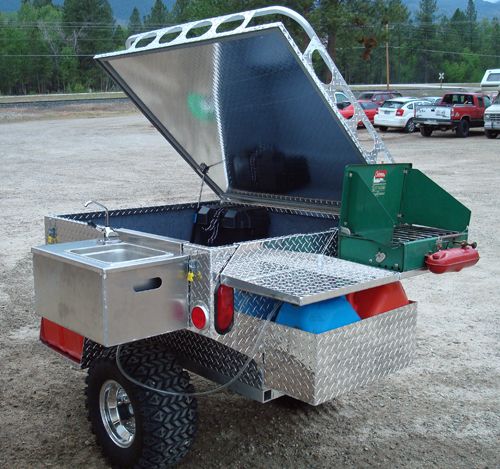
ATV trailers are available in abundance on the market and in specialized stores. They will be the right size, hydraulically lift the body and have many other accessories, but the price of such a product remains sky-high. In various villages and small towns, where an ATV with a good trailer is most in demand, the amount of one and a half - two thousand dollars is unattainable (this is if we talk about the most ordinary trailers). Transportation with various lotions is much more expensive. Their price is at least three thousand dollars.
No way out! There is only one thing left: to make a trailer for an ATV with your own hands. This approach will save you a lot of money. In addition, a do-it-yourself trailer for an ATV will be made the way the owner wants. It will perform all the necessary functions.
If the trailer gets stuck somewhere in a swamp or mud, you can leave it with a clear conscience and not suffer with it.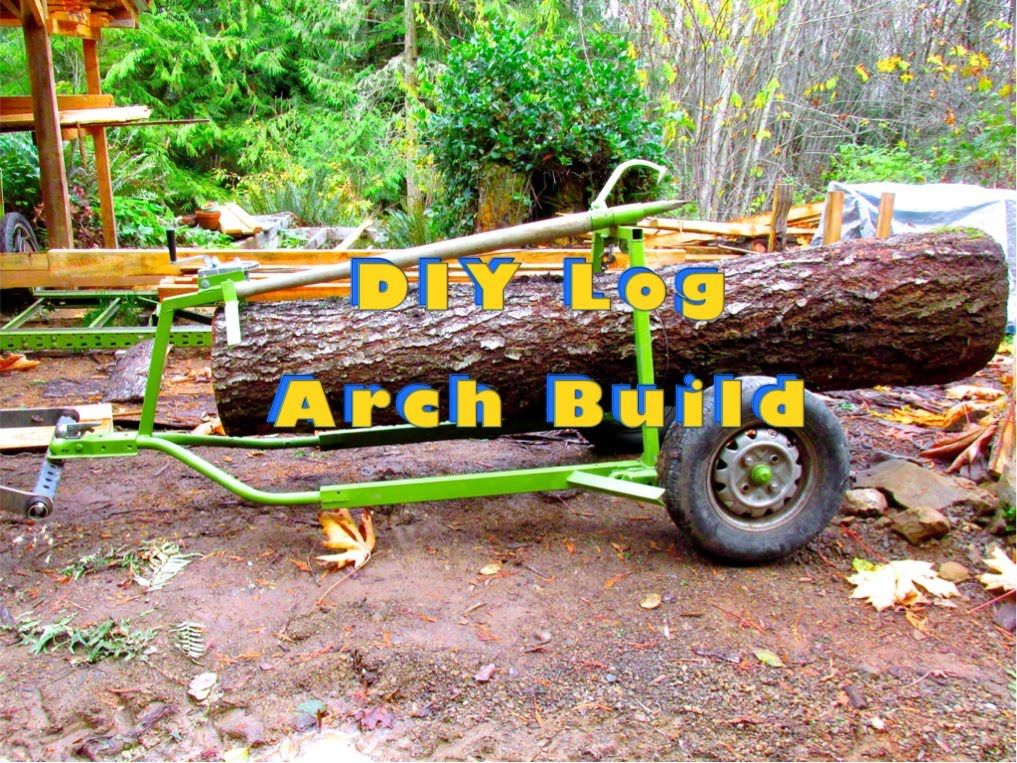 This is another plus of homemade.
This is another plus of homemade.
There are several trailer options (there are many of them, it's a matter of imagination), which differ in design, materials of manufacture and practicality. If desired, everyone can make a trailer for an ATV with their own hands. Equipment, tools and the ability to use them - this is the main issue when creating such a homemade product.
The easiest option for transportation is the "trough" option. It will be a little more difficult to make a classic one, which is very similar to the simplest car trailer. This one will last a very long time. In a classic trailer, you can already transport quite heavy loads, which significantly raises the effectiveness of such a homemade product.
"Trough" version is a tub on wheels. Such a trailer will cost more, as many parts will have to be bought. But everyone can make it. To make such a contraption, you do not need to work hard, it is very simple to manufacture.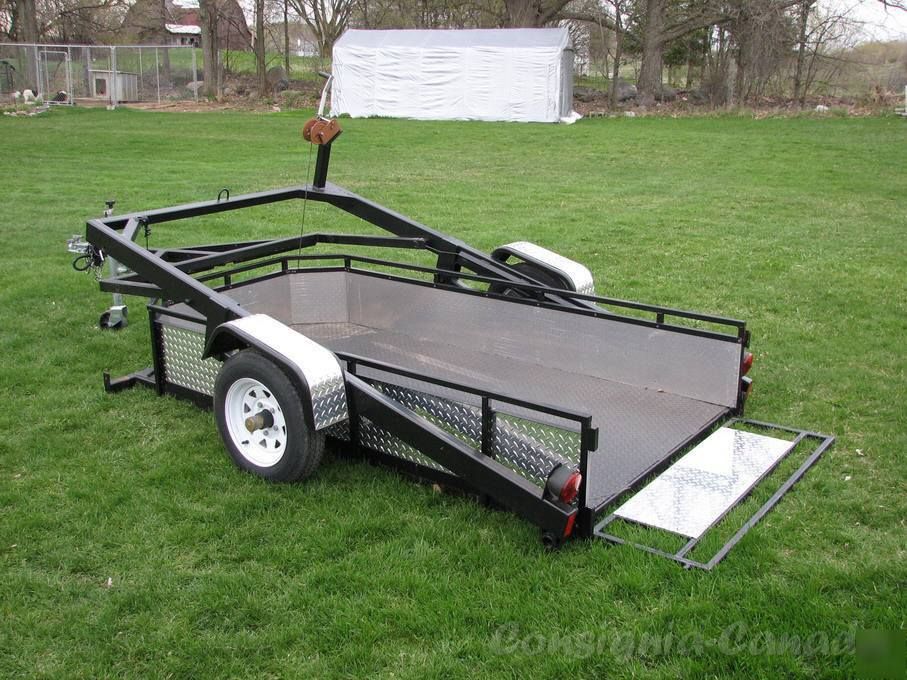 First you need to purchase the body itself. In any hardware store you can buy a large iron trough (something like a bathtub). This will serve as the body. It is important that such a bath does not exceed the width of the ATV itself, but is about the same. This will allow you to maneuver freely in any conditions.
First you need to purchase the body itself. In any hardware store you can buy a large iron trough (something like a bathtub). This will serve as the body. It is important that such a bath does not exceed the width of the ATV itself, but is about the same. This will allow you to maneuver freely in any conditions.
Then you need to weld from a square metal bar (this type of rolled metal) a rectangular frame along the perimeter of the bottom of the trough. It won't be a big deal. It is best to buy an axle for a future trailer in car services or ask a familiar craftsman to make it, as you can pick up problems with the suspension and fasteners. It takes a lot of experience to make this. If it is, then it will again save money.
Bolts will help to fasten the trough and the steel frame. The drill needs to make a couple of holes in the bottom and in the appropriate places on the frame. At this stage, accuracy is very important, so it is better to measure everything several times so that there are no distortions that, due to operation, can cause cracks.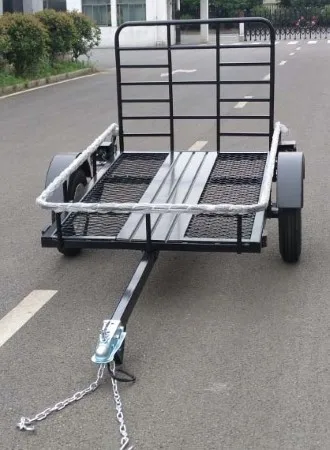 Having drilled holes in the bottom and on the iron profile, you can insert the bolts into the holes and tighten them well with nuts. It is very important to tighten the nuts well so that they do not come loose while riding.
Having drilled holes in the bottom and on the iron profile, you can insert the bolts into the holes and tighten them well with nuts. It is very important to tighten the nuts well so that they do not come loose while riding.
The last step is to attach the drawbar to the body. The drawbar is a beam that holds the tractor and trailer together. It can be made from the same square beam, only the wall thickness needs to be taken more, since when turning, a large load will be transferred to this part. The drawbar is welded to the base of the trough with a welding machine. Also, to strengthen the structure, additional fasteners can be welded at an angle of forty-five degrees.
A homemade ATV trailer, like all other trailers, is connected to the main transport thanks to a special hitch and towbar ball. This mechanism is freely sold on the market or in stores. It can also be removed from old cars. The principle of installation is simple: the hitch ball is screwed or welded to the ATV's rear beam, and the hitch is screwed to the drawbar.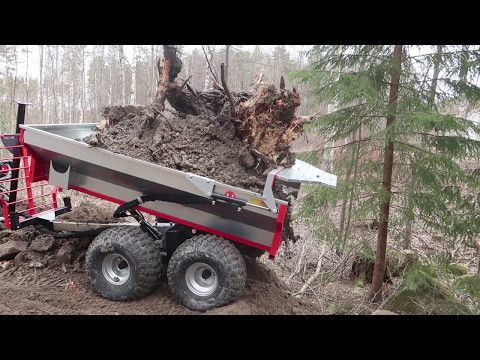 Now the do-it-yourself trailer for an ATV can safely pull loads. It should be borne in mind that this option will not be too heavy-lifting, since the design is a little flimsy. But it can carry not very heavy loads. Bags of cement and other building materials will fit in the back.
Now the do-it-yourself trailer for an ATV can safely pull loads. It should be borne in mind that this option will not be too heavy-lifting, since the design is a little flimsy. But it can carry not very heavy loads. Bags of cement and other building materials will fit in the back.
The classic trailer is an ordinary iron box on wheels. This option will already be more load-bearing and reliable, but it will take more effort to create it.
Be sure to buy an axle with rubber harness suspension. Such axles will be quite cheap. It is this type of suspension that will be the most optimal for a trailer.
All the axles that will be sold do not fit in the width, so they will still have to be shortened. Here you need to calculate so that with the wheels the width of the carriage does not exceed the ATV itself. It turns out such a mini-trailer for an ATV, made by hand, with a shortened axle.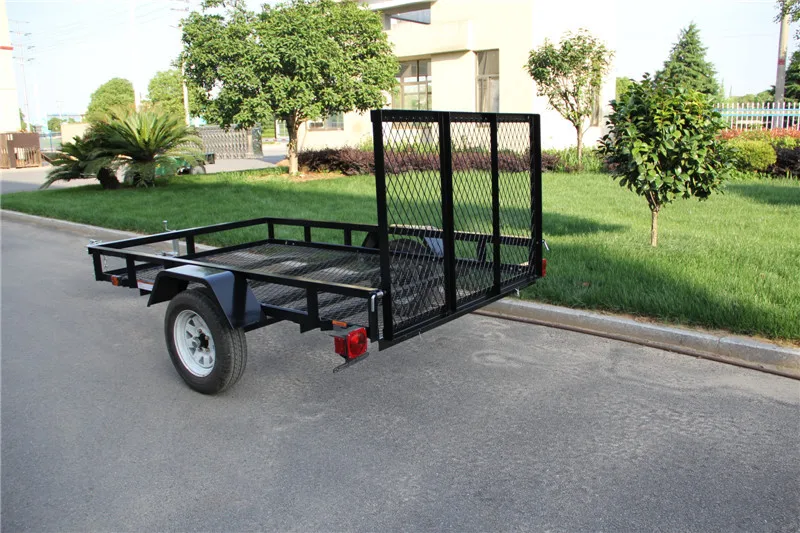
From this axis, you need to cut out the central part, having initially calculated everything. After that, she became shorter. To connect them, you need to pick up a metal pipe of such a diameter that the axle shafts enter there without play. Having inserted the axle shafts into the pipe right in the center, it is necessary to weld the ends. It is important to pour water during welding so that the rubber rollers do not melt.
The drawbar is then welded to the axle at a right angle. It is made from a thicker square metal bar. Then all this is welded to the base.
The trailer body is made depending on the needs of the owner. If this is an ordinary cargo trailer for an ATV, created with your own hands, then everything is done according to the knurled scheme. First, we cook a solid frame from a square metal beam, then we weld an axle to this frame. The remaining parts are welded onto the frame: sides and bottom. When working on the trailer body, it is worth considering the thickness of the sheet metal used for the bottom and sides. It is again calculated from the needs of the owner: the larger the weights planned to be transported, the larger the steel sheet should be.
It is again calculated from the needs of the owner: the larger the weights planned to be transported, the larger the steel sheet should be.
Contents
ATV trailer
Hello everyone! Dear extreme lovers! Those who have ATVs will probably agree with me that this is a beast of a car, and if there is also a trailer with it, in general, you can do a lot of useful things. And they can perform quite a lot of functions: plow your garden with a plow, transport, carry, clean snow with a special blade, or, in another way, with a snow shovel. In this case, we will focus on transportation. For example, use a trailer for an ATV in chores, in transporting things.
If you are interested in a trailer, I think it will be useful to read the following, useful in the future:
Quite a lot can be done on the grills or the trunk of the quad itself, but during operation, many people understand the lack of space on the trunk and hard and soft trunks and purchase a trailer designed directly for the quad bike for their use .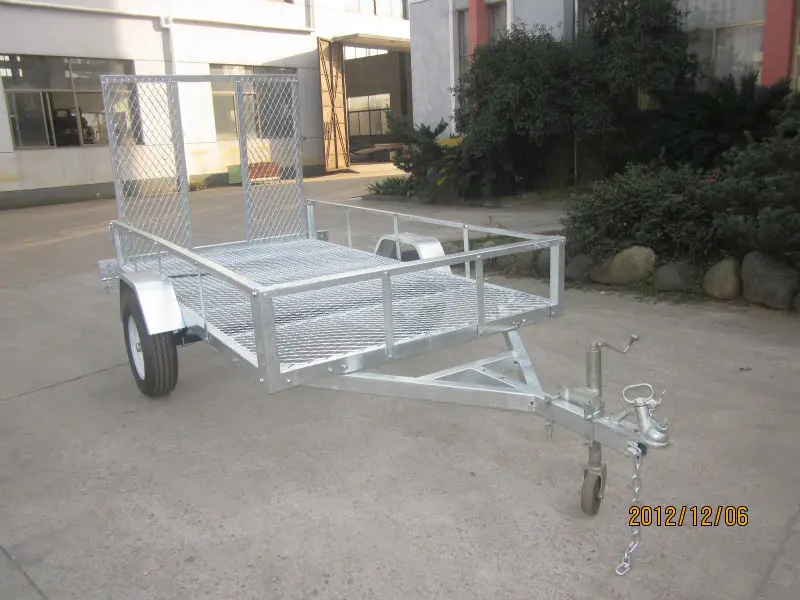 Trailers are most in demand in villages, but in dachas. Where to bring land, where boards, a puddle can be sprinkled with sand, fishermen and hunters can load a boat, tackle, and a motor. A very necessary thing in the household.
Trailers are most in demand in villages, but in dachas. Where to bring land, where boards, a puddle can be sprinkled with sand, fishermen and hunters can load a boat, tackle, and a motor. A very necessary thing in the household.
Low Cost ATV Trailer
It remains to decide which trailer to choose. The price varies from 1500 to 2000 dollars. For fancy ones even more (up to 4000). Decide what you need trailer for transportation of people or all sorts of things? From here and dance already. Here is a fairly budget option
car trailer
It is also possible to consider the option of buying a car trailer from the hands, but it probably won’t be suitable for an ATV, it will be hard for quads with a small cubic capacity. It will come out quite inexpensively, and there is a lot of choice in the ads. But there is one BUT ... will it be convenient to transport it in the forest? after all, the trailer is much wider than the square. Movement between the trees will be difficult, which is important and often found on fishing and hunting, it will also probably become heavy. In this case, all-terrain qualities disappear completely. A car trolley is probably still an unsuitable option.
Movement between the trees will be difficult, which is important and often found on fishing and hunting, it will also probably become heavy. In this case, all-terrain qualities disappear completely. A car trolley is probably still an unsuitable option.
trailer from motoblock
Using a trailer from a walk-behind tractor is generally squalor. The only plus is its width, even narrower than an ATV. Otherwise, there are only minuses: the suspension is unreliable, you can’t load a lot, the wheels are too small, you can’t go far on such off-roads, the size of the body is like a basin))). And you can’t develop speed with such a trailer, the wheels will probably fall off)). Instead of this trailer, it’s probably easier to buy ordinary bags for an ATV
Only one inexpensive solution remains:
DIY ATV trailer
The only option, in my opinion, the cheapest and most reliable is to make a trailer for an ATV with your own hands, unless of course you want to lay out big money for other people's uncles.
Parts of a home-made trailer are best purchased separately, and not taken in pieces from old trailers, so as not to digest or cut anything.
So, let's start with the axis. Probably the most important part in the trailer. We buy an axle in a store, they are sold assembled, or from disassembly, preferably already with suspension and maintenance-free hubs of the most common and inexpensive wheels, for example, from the “classic”. There is a small snag, they are all wide, 170 centimeters, and we need about 120. Therefore, you still have to cut a little. But shortening the axle will still be easier than sawing a car trailer in half to narrow it. So, we saw the axle in half with the help of a grinder, cut off a piece from the middle part, with the expectation that it should turn out to be about 120 centimeters in joining the halves and installing the wheels. This is done so that you can carry your cart where the ATV will pass.
Next, we will dock the halves of the axis. It is necessary to select a pipe with such a diameter that the ends of the axis go inside the pipe without a gap or with a very small one, in order to withstand the collapse, it should be zero. We insert the axle shafts into the pipe section strictly in the center, boil the ends in a circle. The first stage is passed, the axis is ready and the length we need. A good plus of it is the following - it has platforms (mounts) for installing the platform.
It is necessary to select a pipe with such a diameter that the ends of the axis go inside the pipe without a gap or with a very small one, in order to withstand the collapse, it should be zero. We insert the axle shafts into the pipe section strictly in the center, boil the ends in a circle. The first stage is passed, the axis is ready and the length we need. A good plus of it is the following - it has platforms (mounts) for installing the platform.
Next, we think about how and from what we will make the drawbar. For those who do not know, for reference I will say:
The drawbar is what pulls the trailer.
Its variant is constructed from rectangular steel profiles. Choose the size yourself, depending on the planned load on the trailer. The length can also be of any shape (we choose from the calculation of the length of the goods, the longer the load, the correspondingly longer the drawbar).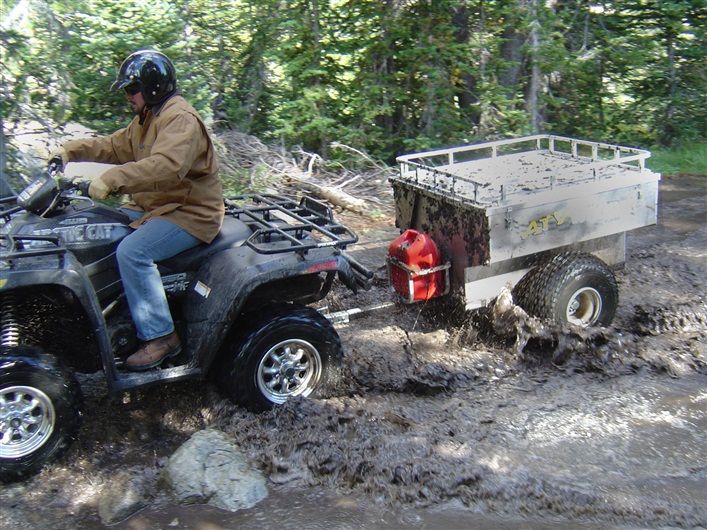 The center of gravity must be on the axle. For reliability, we weld small reinforcements for fastening the drawbar. We do it in any form, as they say, who has what kind of fantasy.
The center of gravity must be on the axle. For reliability, we weld small reinforcements for fastening the drawbar. We do it in any form, as they say, who has what kind of fantasy.
We select the length and width of the site on ours. Since we make it with our own hands, it is possible to choose the dimension for ourselves in advance. It should be convenient for transportation, I think the dimension should approximately correspond to an ATV.
The next step is the coupling itself. We pursue the goal of convenience and speed of docking. In my opinion, the most suitable is to use a standard set that can be found in stores in the public domain - a tow ball and a self-locking ball hitch.
We weld the ball at the back to the device (beam) available on the ATV. The hitch device is bolted to the drawbar. If necessary, shorten the length of the bolts.
Starting to design the frame. The frame must be suitable for the purpose of the trailer.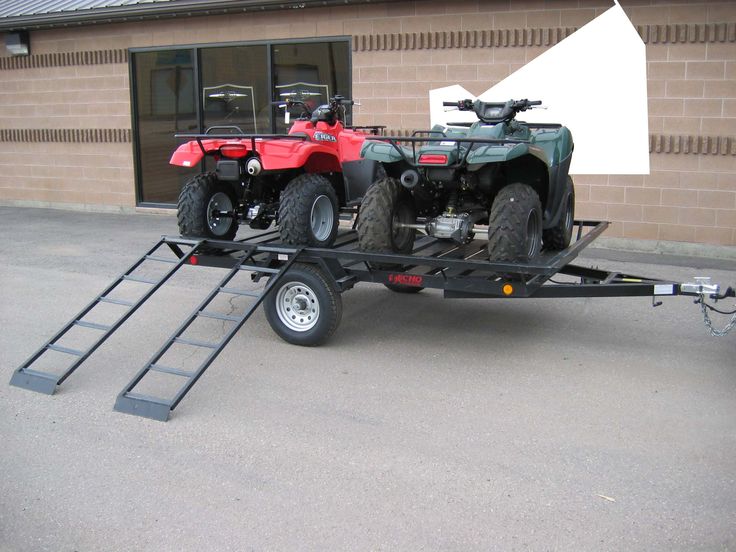 We take steel profiles, measure the desired shape, cut with a grinder, weld together according to the planned option. I think at this stage no one should have questions. The manufacturing structure is elementary.
We take steel profiles, measure the desired shape, cut with a grinder, weld together according to the planned option. I think at this stage no one should have questions. The manufacturing structure is elementary.
The only caveat to consider when welding parts of the frame is a flat surface. We drill holes in the welded frame for attaching the bottom. We cut the bottom out of thick plywood, fasten it to the frame with screws, preferably with countersunk heads, I will explain why. Will not interfere with unloading with a shovel and installing boards. The weight of the trailer should be within 50 kg. In conclusion, the surface can be covered with an anti-corrosion coating for durability , or beaten with a thin iron. With use, of course, the surface will wear out, as a result of which it will be necessary to renew the coating.
Who is interested in the drawings of the trailer, only a slightly different shape
It is impossible to register such a do-it-yourself trailer for one simple reason: the ATV does not have a rear differential, so use with a trailer is prohibited and not desirable for the integrity of the tires.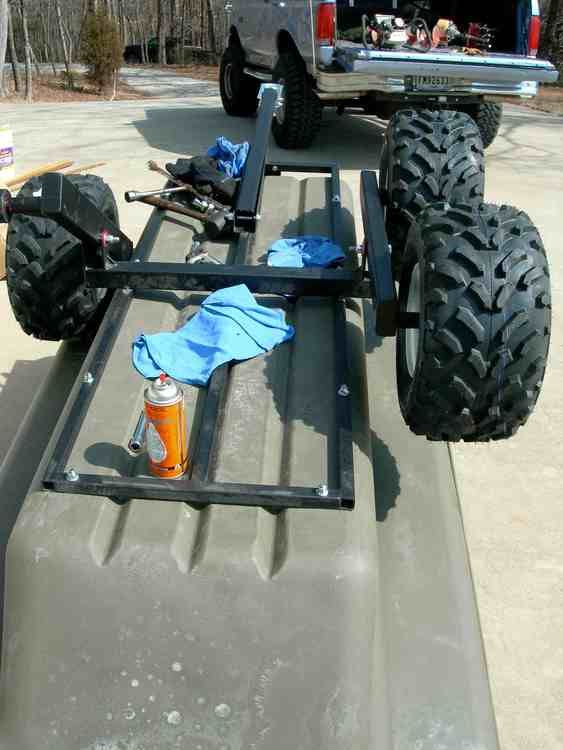 Despite the impossibility of registration, a homemade ATV trailer will serve you for a long time and help out in many situations, and even if it is made by yourself, this is a profitable solution to the problem.
Despite the impossibility of registration, a homemade ATV trailer will serve you for a long time and help out in many situations, and even if it is made by yourself, this is a profitable solution to the problem.
quads with trailer video
Consider next:
ATV trailer
Nowadays, fishermen and hunters are increasingly using vehicles that are unique in terms of cross-country ability. After all, the square really belongs to this category of uniqueness. But you need to somehow deliver it there, and here there is a trailer for transporting or transporting an ATV.
I think it will be useful material to read:
Every year the population of animals and fish decreases and decreases, probably due to non-traditional methods of catching and hunting (poachers do not sleep). And in order to experience worthy pleasure, one has to go further and further into the forest, where others cannot pass. But this forest still needs to be reached. Many overcome both 100 and 200 kilometers on public roads.
And in order to experience worthy pleasure, one has to go further and further into the forest, where others cannot pass. But this forest still needs to be reached. Many overcome both 100 and 200 kilometers on public roads.
If you drive this way on an ATV, you probably don’t even want to fish, and you won’t save enough money for rubber, because driving on asphalt just kills it. Everything is very simple, we use a trailer for transportation: we loaded the ATV, delivered it to the place, unloaded it and went where it was needed.
Many will think: Do we need this expensive hitch to transport an ATV?
Are you thinking of ordering a cargo taxi or taking it with a transport company? I assure you, it will be much more expensive, and it will bring a lot of inconvenience. I explain: firstly, ordering a taxi will require a waste of your time, and secondly: you need to find suitable ramps for loading onto a truck, during transportation you will need to be present (accompany), drive your car, or go with a taxi driver, the cost of such services is very expensive. Believe me, buying a personal trailer will be much cheaper than using transport services.
Believe me, buying a personal trailer will be much cheaper than using transport services.
The farther the destination of transportation, the more profitable and faster the ATV trailer pays off its cost.
So you bought a trailer and with the money saved you can buy cover (plastic) and a manual winch. I think I convinced you, and buying a cart is worth it.
Now let's analyze
protecting it from dirt flying from under the wheels of the car and precipitation.
Trailer cover + frame
trailer cover
Pros: it is quite inexpensive, as it is made of PVC, it washes well from dirt
Cons: not durable material, awning lacing is not a quick process but mandatory, rear visibility is significantly reduced, which makes it difficult to manage; given the area of resistance, the aerodynamics of the car deteriorates and, of course, consumption increases.
ATV Carry Case
ATV Carry Case
The price varies from 2000 to 15000 thousand, depending on the quality of the material and design. The cheap ones go without ties and serve mainly for sheltering ATVs for storage, while the more expensive ones already have ties and a denser synthetic material with a water-repellent layer, stitched with high quality. Minus - the layer peels off when washing the cover, not immediately, but a fact. The aerodynamics are good, but the case is prone to “whipping” when moving at speed, which reduces durability. Significantly increased visibility compared to an awning. Attaching the cover is very simple and does not cause much difficulty.
Plastic trailer cover
plastic cover for trailer
Minus one)))) The cost is quite high and not everyone can afford it, it is about 40,000 thousand. But accordingly, such a cover has more pluses: aerodynamics is increased many times due to the streamlined shape, the metal frame, the presence of the quinoa makes it convenient to roll our quadric into the trailer, it also serves as additional fasteners, and you already think less about how to fix the quadric in the cart.